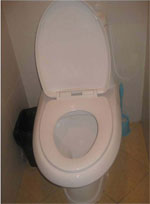20.5 Water carriage systems of human waste disposal
20.5.1 Cistern flush toilet

The cistern flush toilet, also known as a water closet or WC, is usually made of ceramic material (Figure 20.7). The flush toilet consists of two parts: a tank (cistern) that supplies flushwater for carrying away the excreta and a bowl into which the excreta are deposited. It also needs connection to constant running water and a discharge pipe to take the wastewater away to a sewer or septic tank. WCs are rarely found in rural households but are quite common in government offices, some schools and health facilities.
The attractive feature of the flush toilet is that it has a water seal to prevent odours from coming back up through the plumbing. A skilled plumber is needed to install a flush toilet. From the users’ perspective, it is a safe and comfortable toilet to use provided that it is kept clean, but the high capital cost for installation and the need for skilled personnel makes it not affordable by every family, especially those living in rural areas.
20.4.2 Fossa Alterna – a double pit method
